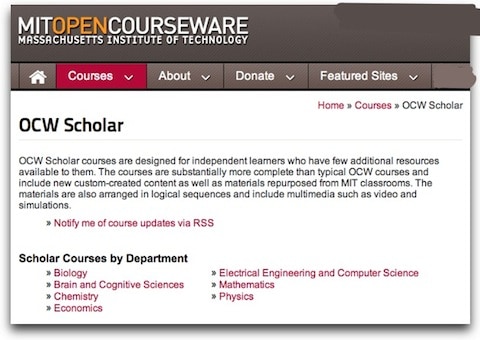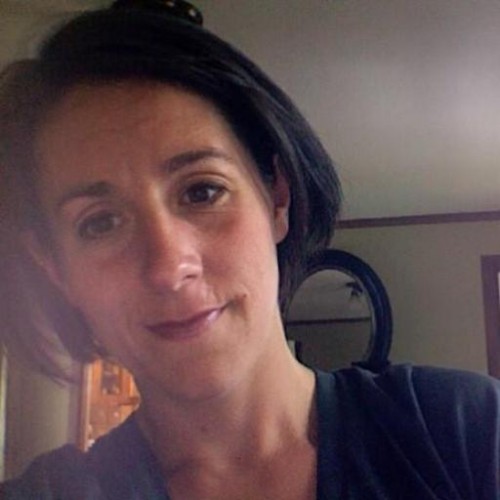Using OpenCourseware at New Milford HS to Create Deeper Learning

Juliana Meehan attended the Edscape Conference in the fall of 2012, the annual professional development event hosted each year by Principal Eric Sheninger at New Milford High School located in Bergen County, NJ. Juliana loved what she saw and knew the school possessed the culture needed to sustain deeper learning for students. As part of NJExcel, a principal certification program, she needed to create a project and asked Eric to serve as her mentor. The two met over the summer to brainstorm the type of project that would bring to life both Eric’s and Juliana’s strong belief that all students can learn at a deeper level and achieve huge levels of success when they are afforded the freedom to self-direct and choose how to demonstrate their learning.
How does the program start? This principal and principal-in-training agreed to use the “independent study” model for this new program. They decided that in the fall of 2012, the Independent OpenCourseware Study would be an option for students in New Milford’s academy program, which includes the students who choose to get ahead of the game by taking rigorous academic courses in order to be career and college ready. They would have the option to choose any subject they felt passionate about and study it using available OpenCourseware from esteemed institutions such as MIT or Stanford, to learn more about their chosen subject. The project would last two months, they would present their learning in any manner that felt right to them and they would earn one credit, even though the course work was all done on their own time- outside of the designated school day.
Although there was immediate buy in from about 50 students, they were did not necessarily respond with applause and cheering. Instead, the first weeks of the project consisted mostly of face to face meeting with Eric or their guidance counselor to mentor the students and talk them through the strong anxiety that surrounded not being given specific “step by step” instructions for what their finished product needed to look like. The students did receive a rubric along with mentor support, but ultimately it was up to the student to decided how and what to present at the end of the two months. These students realized they were going to have to take ownership of their learning in order to earn the credit, all the while having the chance to truly experience a project that held potential to give them a big leg up as they prepared to enter college.
Where do the students start? As the initial student anxiety subsided, the real fun began. Students jumped in and chose incredible topics that suited their passions and interests. They introduced themselves to psychology and nursing, business, programming, sociology and engineering. They dove deeper with high level courses in physics, chemistry, political sciences and history. The studied specific topics like Alzheimers, nutrition, animal behavior and physical fitness. In fact, the topics were so diverse, they hit almost every area of study imaginable, from arts and sciences to every branch of STEM.
The learning resources came from prestigious universities throughout the country that offer free and open courseware for anyone interested in learning. Most students zeroed in on MIT’s offerings, but others utilized courses from Yale, Brown, Cal Berkley, Notre Dame and many more. In fact, MIT was so intrigued by how these high school students were successfully leveraging open content, they reached out to Eric for a case study and to create a partnership to provide these deeper learning experiences for more students with a structured independent study program like this one being established at New Milford.
This first year of IOCS at New Milford culminated with presentations from each of the students to all of their peers, who were encouraged to ask questions and offer feedback. The thinking is that next year, these presentations will evolve into more of a “Gallery Walk” so that all the stakeholders may attend and gain more understanding into the depth and the possibilities of this program. There are plans to extend the program throughout the year so that students can earn more credits as they work to ready themselves for the next steps after high school.
Where do others start? The good news is that this model created at New Milford is completely scalable. The most essential requirement is that students have access to the internet. All this powerful learning content is free and available to anyone who has access to the internet. The other, underlying but equally as essential element is a school culture that is accepting and supportive of having students work through through this process, that can definitely feel uncomfortable and look messy at times.
What is the true payoff of a program like this for the students? Yes, there was an initial kind of “freak out” when students realized the only non-negotiable of the project was that they would NOT receive an outline specifying the expectations of the final project – but they worked through it. Yes, they learned about motivating and interesting topics using online content and digital learning strategies that are beyond the typical, comprehensive high school curriculum. And, yes, students recognized that they learned what it feels like to actually be a college student and gained the self awareness for what else they need to do in order to be truly prepared for what happens after graduation. In fact, there is even an incredible new and revised rubric, aligned to all these lessons and shared on the IOCS site that explains, in detail, all the incredible benefits students can gain from challenging themselves and investing in this form of learning.
These students utilized critical thinking, problem solving skills and creativity that doesn’t come about in a highly structured environment. Allowing students to engage in a framework that blends traditional and nontraditional learning like this truly helps create an entire school culture reminiscent of the real world in which these students will very soon find themselves.




0 Comments
Leave a Comment
Your email address will not be published. All fields are required.